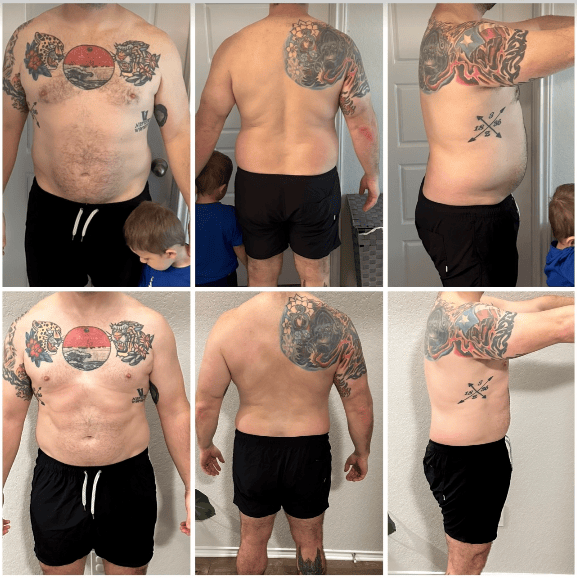My low-end recommendation is to get at least 8,000 steps per day and ideally I think hitting somewhere around 12,000 is going to massively benefit most people. I will give the rationale for both those recommendations below.
Unfortunately, we are nowhere near those numbers. Before COVID the average American was only getting around 5,117 steps per day [1] and the pandemic may have reduced that already low number by more than 2,000 steps [2].
This means we have a lot of work to do on both the individual and group level to increase our movement as well as support and normalize more movement within our communities [3, 4].
Why 8,000?
At around ~8,000 steps per day it looks like our appetite is significantly more regulated [5-7]. To explain this as simply as possible, it looks when we get less movement our hunger is out of whack with how many calories we burn in the day, but when we increase our activity levels our energy intake becomes more coupled or in sync with the energy we expend.
This has been shown again and again, but it was first published in a study of 213 mill workers in West Bengal in 1956 [8]. “Below the “sedentary zone” a decrease in activity is not followed by a decrease in food intake but, on the contrary, by an increase. Body weight is also increased in that zone.” -Mayer et al., 1956 [8]
Getting at least 8,000 steps can also significantly lower one’s risk of death [9, 10], as well as help us adapt and recover from exercise [11, 12].
Improving baseline step counts by just ~25% has also been found to augment results from exercise, improve sleep quality, lower blood pressure, decrease body fat, as well as increase cardiorespiratory fitness and physical abilities [13-15].
HUGE WINS!!!
Now, why 12,000 over 8,000?
It looks like successful weight loss maintainers get an average of 12,107 steps per day [16] and higher amounts of physical activity appears to be one of the most important behaviors when it comes to long-term weight loss success [7, 17-19]. Furthermore, a recent study by Browne and colleagues out of UCLA [20] found that by increasing individuals step counts from 7,500 to around 12,000 they were able to progressively lose roughly ~7% body fat in one year with NO nutrition intervention [20]!
Also, in one of the most recent meta-analyses, the risk of death decreased linearly from 2,700 to 17,000 steps per day [21]. In comparison to 2,700 steps per day getting 8,000 steps per day reduced one’s risk of death by a mind-boggling 48%, yet 12,000 steps per day resulted in a monumental and unheard of 59% reduction in all-cause mortality risk compared to that same 2,700 steps per day.
At this point, I hope I just may have convinced you that increasing movement can be unbelievably powerful and extremely helpful, but we haven’t talked about the most important part…
HOW do we do it?!
As a general rule of thumb 1,000 steps is around 10 minutes of walking, thus if most people are getting somewhere around 5,000 steps per day pushing this to 8,000 would take an additional 30 minutes of walking. Not too terrible, but not exactly a short amount of time either.
My personal recommendation would be to try to stack two 15 minute walks before or after something you already do every day.
Some common examples could be when we wake up, after breakfast, before lunch, right when we get home from work, or after dinner. Attaching a new habit to an existing cue is called habit stacking and we have talked about it HERE.
I do think trying to do little things every day like remembering to park further away at the grocery store or take the stairs could work, but it probably isn’t going to lead to the most consistency [22].
It is probably better to change your environment and habits over time to make it more normal to get more steps and then work to build routines so that getting more steps becomes automatic and you don’t really have to remember or think about it any more [4, 23].
Individualized feedback and monitoring, as well as personalized goal setting could also help and especially so in the beginning [20, 24, 25].
Now, 12,000 steps is a different animal because for most people we are talking about an additional ~70 minutes of walking during the day…every day.
This level of time commitment probably means saying no to other things we may want or absolutely have to do. This is especially true if someone has a sedentary job and many other pressures on their time like a family.
In these scenarios, I think we have to chunk walking with something else like phone meetings or even in-person meetings. This can be quite hard and honestly quite stressful and it is why if people are in this time-limited conundrum where getting steps could be taking them away from other activities or people they love I will highly recommend spending money on a walking treadmill and a standing desk.
With a sedentary job and a young toddler, I am personally in this situation. For example, I know how important movement is and I know all the habit hacking tricks, yet without a walking treadmill there is absolutely no chance I hit 12,000 steps a day consistently without being a psychopath and sacrificing a lot of time with my family.
Therefore, I threw money at the solution and that is a privilege and also a no brainer as it is aligned with my values systems.
As I finish typing this sentence my pedometer reads 12,633 steps and I can shut it all down and play with our daughter outside.
Now if you are a single 20 something who loves to listen to podcasts while they walk, you are probably going to be able to get to 12,000 just fine. But, maybe take it easy on us older folks with mortgages, soccer practices, and two car garages. I've been that cringey kid and I think it is better if we all try to walk a mile in someone else's shoes before we dole out flippant and unrealistic recommendations.
Thank you for your effort!
#GIVEAFIT

REFERENCES:
1. Bassett, D.R., Jr., et al., Pedometer-measured physical activity and health behaviors in U.S. adults. Med Sci Sports Exerc, 2010. 42(10): p. 1819-25.
2. Dunton, G.F., et al., Early effects of the COVID-19 pandemic on physical activity locations and behaviors in adults living in the United States. Prev Med Rep, 2020. 20: p. 101241.
3. Althoff, T., et al., Large-scale physical activity data reveal worldwide activity inequality. Nature, 2017. 547(7663): p. 336-339.
4. Creatore, M.I., et al., Association of Neighborhood Walkability With Change in Overweight, Obesity, and Diabetes. JAMA, 2016. 315(20): p. 2211-20.
5. Beaulieu, K., et al., Homeostatic and non-homeostatic appetite control along the spectrum of physical activity levels: An updated perspective. Physiol Behav, 2018. 192: p. 23-29.
6. Shook, R.P., et al., Low levels of physical activity are associated with dysregulation of energy intake and fat mass gain over 1 year. Am J Clin Nutr, 2015. 102(6): p. 1332-8.
7. Melby, C.L., et al., Increasing Energy Flux to Maintain Diet-Induced Weight Loss. Nutrients, 2019. 11(10).
8. Mayer, J., P. Roy, and K.P. Mitra, Relation between caloric intake, body weight, and physical work: studies in an industrial male population in West Bengal. Am J Clin Nutr, 1956. 4(2): p. 169-75.
9. Paluch, A.E., et al., Steps per Day and All-Cause Mortality in Middle-aged Adults in the Coronary Artery Risk Development in Young Adults Study. JAMA Netw Open, 2021. 4(9): p. e2124516.
10. Lee, I.M., et al., Association of Step Volume and Intensity With All-Cause Mortality in Older Women. JAMA Intern Med, 2019.
11. Akins, J.D., et al., Inactivity induces resistance to the metabolic benefits following acute exercise. J Appl Physiol (1985), 2019. 126(4): p. 1088-1094.
12. Burton, H.M. and E.F. Coyle, Daily Step Count and Postprandial Fat Metabolism. Med Sci Sports Exerc, 2021. 53(2): p. 333-340.
13. Sullivan Bisson, A.N., S.A. Robinson, and M.E. Lachman, Walk to a better night of sleep: testing the relationship between physical activity and sleep. Sleep Health, 2019. 5(5): p. 487-494.
14. Hanson, S. and A. Jones, Is there evidence that walking groups have health benefits? A systematic review and meta-analysis. Br J Sports Med, 2015. 49(11): p. 710-5.
15. Swift, D.L., et al., The Effect of Aerobic Training and Increasing Nonexercise Physical Activity on Cardiometabolic Risk Factors. Med Sci Sports Exerc, 2021. 53(10): p. 2152-2163.
16. Ostendorf, D.M., et al., Physical Activity Energy Expenditure and Total Daily Energy Expenditure in Successful Weight Loss Maintainers. Obesity (Silver Spring), 2019. 27(3): p. 496-504.
17. Church, T.S. and C.K. Martin, Exercise is the Key to Keeping Weight Off, but What is the Key to Consistently Exercising? Obesity (Silver Spring), 2019. 27(3): p. 361.
18. Foright, R., et al., Effects of Exercise during Weight Loss Maintenance on Appetite Regulation in Women. Transl J Am Coll Sports Med, 2020. 5(12).
19. Foright, R.M., et al., Is regular exercise an effective strategy for weight loss maintenance? Physiol Behav, 2018. 188: p. 86-93.
20. Browne, J.D., et al., Lifestyle Modification Using a Wearable Biometric Ring and Guided Feedback Improve Sleep and Exercise Behaviors: A 12-Month Randomized, Placebo-Controlled Study. Front Physiol, 2021. 12: p. 777874.
21. Jayedi, A., A. Gohari, and S. Shab-Bidar, Daily Step Count and All-Cause Mortality: A Dose-Response Meta-analysis of Prospective Cohort Studies. Sports Med, 2021.
22. Loewenstein, G., Self-Control and Its Discontents: A Commentary on Duckworth, Milkman, and Laibson. Psychol Sci Public Interest, 2018. 19(3): p. 95-101.
23. Arlinghaus, K.R. and C.A. Johnston, The Importance of Creating Habits and Routine. Am J Lifestyle Med, 2019. 13(2): p. 142-144.
24. Bailey, R.R., Goal Setting and Action Planning for Health Behavior Change. Am J Lifestyle Med, 2019. 13(6): p. 615-618.
25. Spreckley, M., J. Seidell, and J. Halberstadt, Perspectives into the experience of successful, substantial long-term weight-loss maintenance: a systematic review. Int J Qual Stud Health Well-being, 2021. 16(1): p. 1862481.
About Author: Mario Mendias





